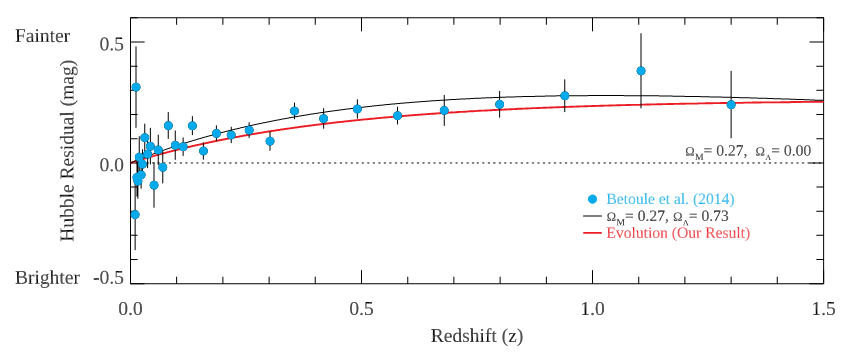- 제목
- New evidence shows that the key assumption made in the discovery of dark energy is in error
- 작성일
- 2020.01.05
- 작성자
- 천문우주학과
- 게시글 내용
-
PRESS RELEASE For immediate release: January 5, 2020
New evidence shows that the key assumption made in the discovery of dark energy is in error
High precision age dating of supernova host galaxies reveals that the luminosity evolution of supernovae is significant enough to question the very existence of dark energy
The most direct and strongest evidence for the accelerating universe with dark energy is provided by the distance measurements using type Ia supernovae (SN Ia) for the galaxies at high redshift. This result is based on the assumption that the corrected luminosity of SN Ia through the empirical standardization would not evolve with redshift.
New observations and analysis made by a team of astronomers at Yonsei University (Seoul, South Korea), together with their collaborators at Lyon University and KASI, show, however, that this key assumption is most likely in error. The team has performed very high-quality (signal-to-noise ratio ~175) spectroscopic observations to cover most of the reported nearby early-type host galaxies of SN Ia, from which they obtained the most direct and reliable measurements of population ages for these host galaxies. They find a significant correlation between SN luminosity and stellar population age at a 99.5% confidence level. As such, this is the most direct and stringent test ever made for the luminosity evolution of SN Ia. Since SN progenitors in host galaxies are getting younger with redshift (look-back time), this result inevitably indicates a serious systematic bias with redshift in SN cosmology. Taken at face values, the luminosity evolution of SN is significant enough to question the very existence of dark energy. When the luminosity evolution of SN is properly taken into account, the team found that the evidence for the existence of dark energy simply goes away (see Figure 1).
Commenting on the result, Prof. Young-Wook Lee (Yonsei Univ., Seoul) who was leading the project said; "Quoting Carl Sagan, extraordinary claims require extraordinary evidence, but I am not sure we have such extraordinary evidence for dark energy. Our result illustrates that dark energy from SN cosmology, which led to the 2011 Nobel Prize in Physics, might be an artifact of a fragile and false assumption".
Other cosmological probes, such as CMB (Cosmic Microwave Background) and BAO (Baryonic Acoustic Oscillations), are also known to provide some indirect and "circumstantial" evidence for dark energy, but it was recently suggested that CMB from Planck mission no longer supports the concordance cosmological model which may require new physics (Di Valentino, Melchiorri, & Silk 2019). Some investigators have also shown that BAO and other low-redshift cosmological probes can be consistent with a non-accelerating universe without dark energy (see, for example, Tutusaus et al. 2017). In this respect, the present result showing the luminosity evolution mimicking dark energy in SN cosmology is crucial and is very timely.
This result is reminiscent of the famous Tinsley-Sandage debate in the 1970s on luminosity evolution in observational cosmology, which led to the termination of the Sandage project originally designed to determine the fate of the universe.
This work based on the team's 9-year effort at Las Campanas Observatory 2.5-m telescope and at MMT 6.5-m telescope was presented at the 235th meeting of the American Astronomical Society held in Honolulu on January 5th (2:50 PM in cosmology session, presentation No. 153.05). Their paper is also accepted for publication in The Astrophysical Journal and will be published in January 2020 issue.
Paper title: Early-Type Host Galaxies of Type Ia Supernovae. II. Evidence for Luminosity Evolution in Supernova Cosmology
Authors: Yijung Kang, Young-Wook Lee (Yonsei Univ., South Korea), Young-Lo Kim (Lyon Univ., France), Chul Chung (Yonsei Univ.), & Chang Hee Ree (KASI, South Korea)
CONTACTS:
Young-Wook Lee (project leader & corresponding author)
Director & Professor of Astrophysics
Center for Galaxy Evolution Research & Department of Astronomy
Yonsei University, Seoul, South Korea
e-mail: ywlee2@yonsei.ac.kr
Yijung Kang (first author)
Postdoctoral Researcher
Center for Galaxy Evolution Research & Department of Astronomy
Yonsei University, Seoul, South Korea
e-mail: ykang@gemini.edu
(Present address: Gemini Observatory, La Serena, Chile)

Figure 1. Luminosity evolution mimicking dark energy in supernova (SN) cosmology.
The Hubble residual is the difference in SN luminosity with respect to the cosmological model without dark energy (the black dotted line). The cyan circles are the binned SN data from Betoule et al. (2014). The red line is the evolution curve based on our age dating of early-type host galaxies. The comparison of our evolution curve with SN data shows that the luminosity evolution can mimic Hubble residuals used in the discovery and inference of the dark energy (the black solid line).
- 저자명
